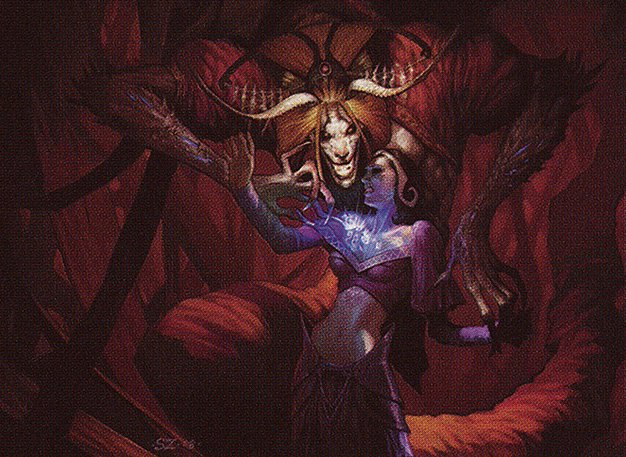The Prison of Silver
This content was deleted from the Magic website during an update. The original page can be accessed via Wayback Machine here.
By Doug Beyer
Last time, we saw how Sorin, the grandson to the forefather of all of Innistrad’s vampires, came to create the angel called Avacyn.
Today, we discover just what happened to that angel—and we’ll get to see the card that was her downfall. But before we get to that, we have to dive back into the history of Innistrad.
Tales of Demonkind
Even before the time of Sorin Markov and his grandfather Edgar, before Innistrad’s race of vampires existed, the people of Innistrad feared demons. Few of these demonic creatures ever made themselves manifest, to the point that some believed demons were mythical or long dead. But others knew the legends of wicked demon-spawn were true and they feared the day when the demons would return.

Edgar Markov created vampirism on Innistrad thanks in part to the prodding of a fiendish figure called Shilgengar. Shilgengar was one of few demons to exist on the surface of Innistrad at the time, and as it turned out, he became a kind of harbinger for his own kind. Edgar inflicted his curse of vampirism on his grandson, Sorin, awakening Sorin’s latent planeswalker spark. And later, Edgar’s actions indirectly led to a resurgence of demons in the world.
Now a planeswalker, Sorin lived and traveled and fed his vampiric thirst for decades, and then the decades stretched into centuries. When he returned to Innistrad and saw the threat to life on Innistrad that vampires and other supernatural monsters represented, Sorin took action. He created the archangel Avacyn to safeguard humanity, providing both vampires and humans a way to subsist in the world.
And Avacyn carried out her assignment with zeal.
Avacyn’s Campaign
The archangel Avacyn and her host of angels took up the sword against those who would harm humanity. They slew vampires with holy fervor, prompting Sorin’s kin to brand him a traitor to their kind. The angels thrashed the werewolf howlpacks that threatened to overwhelm those towns bordering the wilds. They banished malevolent geists that haunted the shipwrecks and ancient manors of the plane. They incinerated unholy ghouls with piercing light. They were never able to cleanse the plane of evil, but Sorin’s creation had done her job.

Humanity was able to flourish again. The Church of Avacyn grew up around the archangel, and faith in her helped fend off the flesh-hungry monsters. The power balance on the plane tipped in humanity’s favor.
None could have foreseen what evils this would bring.
Demons and Devilry
The retreat of the supernatural fiends of the plane opened a space—an opportunity for Innistrad’s infernal forces to manifest. Like Shilgengar long before, the demons and their hosts of impish devils began to make their presence known in far greater numbers.
Avacyn engaged each demon in single combat, defeating them one by one. She found that new demons would appear a short time later and decreed: “What cannot be destroyed must be bound.” She then forged a collar of silver to bind demonkind, so they could be hauled away and imprisoned. The Silver Collar became Avacyn’s symbol and the holy symbol carried by Avacynian priests and cathars.
The Helvault
One by one, Avacyn and her host of angels captured the demons, imprisoning them in a huge mass of silver that came to be called the Helvault. Said to be a piece of Innistrad’s silver moon, the Helvault sits in the cathedral yard in the High City of Thraben overlooking a cliff’s edge and the sea beyond. Stories say it and Avacyn first appeared on the same night, and it remains the most holy object on Innistrad after Avacyn herself.
With the proper incantations and rituals, Avacyn and her angelic host could cause wicked creatures to be drawn into the Helvault. She trapped so many demons within the Helvault that only a handful remained. To the relief of all but the demon-worshipping Skirsdag cult, demons and devils were largely out of human life.
It was only a short time ago that the demon Griselbrand, the most powerful of his kind and one who had never become imprisoned, committed an act of unprecedented boldness and heresy: he landed on the Helvault itself, under a full moon, and challenged Avacyn to combat.
Avacyn and Griselbrand battled for days, out of view of all but Avacyn’s host; the Lunarch, Mikaeus; and his most trusted bishops. Finally, in an act of desperate effort, Avacyn used all of her remaining strength to drive Griselbrand into the Helvault. As his final act, Griselbrand threw his spear and impaled the archangel’s heart. The binding spell backlashed as she was impaled, and Avacyn was drawn into the Helvault herself.
Innistrad’s most powerful demon was now encased in a great silver mass, as was the archangel Avacyn herself, keystone of the Church and protector of humankind. The words of her own spell imprisoned her: “What cannot be destroyed must be bound.”
The waning of the light
Avacyn was gone. The lunarch reeled. Church officials struggled with what to tell the general populace, and whether to keep Avacyn’s imprisonment a secret. As the days and weeks went by, practitioners of the faith felt the effects. Holy wards failed and prayers to Avacyn went unanswered. Avacyn’s host of angels dwindled and were seen more and more rarely. Rumors abounded that Avacyn had abandoned the world, leading to a crisis of faith across all four provinces. The evil creatures that were once held back by Avacyn’s power, sensing the absence of holy might, became bolder and hungrier. With humanity’s safeguard trapped within her own silver vessel, the people of Innistrad are now left exposed to the creatures of the night.

The puzzle is really coming together now. Last fall, you learned all about Innistrad and its faith based around Avacyn. You learned about her collar-shaped holy symbol and the importance of silver, and about how she had gone missing. Last week, you learned about the role of Sorin, and how his vampiric ancestry led him to create Avacyn to protect the world from his own kind. Now you know the next piece of the puzzle: the Helvault, the prison that to this day encases the archangel, which has allowed the predatory evils of the plane to thrive. There’s more to this story to come, but for now we take a break to talk about a Dark Ascension card.
Oh yeah—the Helvault is a Dark Ascension card.
The Helvault in card form
We’ve seen what role the Helvault plays in Innistrad’s history. Now let’s see it in action.

The Helvault is a legendary artifact that swallows creatures, imprisoning them within itself for timeless eternities so they can think about what they did. At three mana, it can show up early, casting a long shadow over the battlefield.
The Helvault is a prison without mercy, keeping both friend and foe inside its silvery bulk. For only one mana you can stash away one of your own creatures inside the ‘vault, perhaps saving it from dying to a removal spell or a lethal round of combat. Since the Helvault whisks your creatures away via exile, they never touch the graveyard, so you can also prevent “dies” triggers from triggering—particularly relevant in Innistrad block. You might be able to use the Helvault to prevent your opponent from taking advantage of a “morbid” ability or thwart the ultimate ability of Sorin, Lord of Innistrad.
If you have a way to crack open your Helvault, you’ll be able to get all your own creatures back onto the battlefield in one fell swoop. You could store up creatures in the Helvault, using it like a new-fangled Safe Haven, intending to Day of Judgment away all your opponent’s stuff and still have your own guys safely tucked away inside. Solid chunk of mystical silver or no, all the freeing process really takes is a way to destroy an artifact, so you could simply Naturalize your Helvault to undo all your self-exiling and liberate your minions. Or maybe you could do some clever stack tricks with a Manic Vandal? In response to the Vandal’s enters-the-battlefield trigger targeting the Helvault, spend a mana and put the Vandal in the Helvault, and when it pops back out you will get a second Vandal trigger to blow up your opponent’s Sword or whatever.

There is an even faster way. Since the Helvault is legendary, you can also just cast another copy of Helvault to crack the moon-chunk in two, blowing them both up and setting free all your creatures.
But of course, the original purpose of the Helvault was not to imprison friendly creatures, but to stash away all those awful, wicked beasts that your opponent insists on summoning. The Helvault retains that function, albeit at a much greater cost. For seven, you can use the Helvault like Avacyn once did, sealing away all those horrible demons, devils, vampires, zombies, and Brushwaggs your enemies control. Once you get up to seven mana, you’ve got a rapid-fire Lux Cannon on your hands, a silvery Alcatraz so hungry for inmates that it can put one behind bars every turn. Use the Helvault as a weapon to seize gradual control of the board and the game, leaving mana up to keep it safe from Shatters that would break its unholy prisoners free.
Note that the Helvault is quite handy at dealing with creatures that have the new undying mechanic—the ability that lets monsters come back from the dead stronger than they were before. The Helvault exiles those relentless beasts straightaway. It’s just like Avacyn’s decree: “What cannot be destroyed must be bound.”
The deathmage’s next move
I leave you today with one final thought, storyline fans. The demon who challenged Avacyn and dragged her down into the Helvault with him? The one who stole away the world’s angel of hope and effectively rang in a new era of darkness across the world? His name is Griselbrand, and he’s an ancient and powerful demon worshipped by the Skirsdag cult (see, for example, Disciple of Griselbrand). But haven’t we heard his name in another context as well? Wasn’t he…?

Ohhh yeah. Griselbrand is one of the four three demon lords to whom Liliana Vess surrendered her soul. He’s one of Liliana’s demonic creditors, and therefore he’s in her way, if she ever hopes to get that pesky soul of hers back. He’s the demon that Liliana came to Innistrad to hunt down and, ideally, kill. Now we know the reason she hasn’t found and slain Griselbrand already—the demon is hidden away inside a massive chunk of moon-silver in the inner sanctum of Thraben Cathedral in the plane’s most holy city, guarded by walls, cathars, and the careful secrecy of the Church’s elite.
What’s a deathmage to do?
